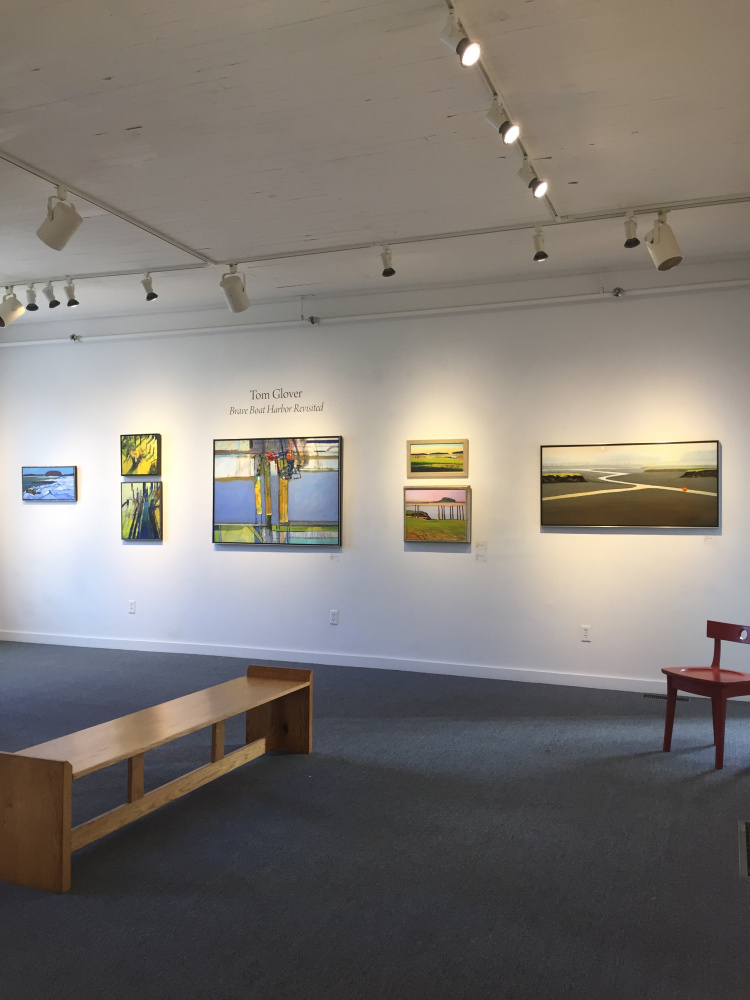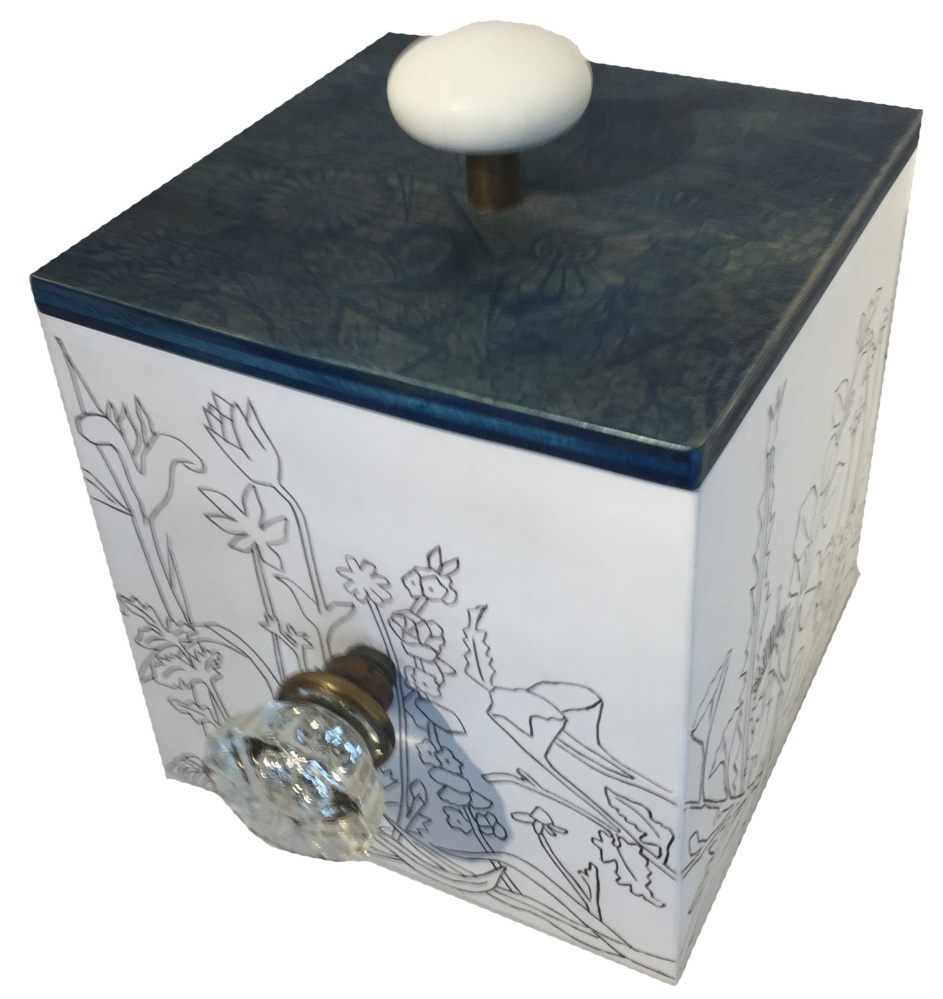Rollinsford, New Hampshire, painter Tom Glover’s exhibition “Brave Boat Harbor Revisited” explores the topography of a specific place. But the 30 paintings also create a visual conversation in genre, structure and painterliness.
It’s an interesting time to see such a show, particularly on the heels of this summer’s Alfred Chadbourne exhibition at the Ogunquit Museum of American Art, which reminded us that the sophisticated tributaries of modernism entered Maine on many currents and estuaries. Chadbourne’s particular strength was well-structured value-based compositions. And the first painting to truly grasp and hold your attention in Glover’s show is the muscular and Chadbourne-like “Truss Abstraction in Blues.”
To the right of “Truss Abstraction,” however, is a landscape painting closer to the style of Stephen Etnier that is no less arresting. “Sun Breaking Through” is a horizontal scene featuring a channel stream through the gray-brown muddy flats of low tide. The leitmotif of the island anchors the high landscape horizon. Echoing an orange ball of a buoy in the right foreground’s narrow stream, a subtle sun is just burning through the morning haze.
The sun becomes punctuation to the scene. It is in the upper left, just off-center. After our eye flows with the water past a tributary to the left, continuing down to the buoy in the lower right, the scene takes on a more solid structure. Our eye returns to the sun again and again on the diagonal running from the lower right toward the upper left. The more we look, the more solid the sun becomes, until it feels like a rising and brightening sun of a Maine coastal morning. It is an extraordinary composition that makes for an unusually satisfying painting.
“Truss Abstraction” is a very different thing. Instead of positioning the viewer’s body outside in the landscape, we find ourselves looking at a painting with the assumption of its rectangular completeness. This is in fact why it is an abstraction. The trusses are readily identifiable, but neither they nor anything else in the painting transports us from the here-and-now experience of a painting to a there-and-then taste of the painter’s on-site subjectivity associated with paintings of places, people or things. There is nothing here that implies a continuing landscape. Horizontal bands at the top and bottom of the painting look almost to be cobbled together of boards and physical material. But reaching through the immaterial cerulean center are three muscular forms, slowly decaying trusses of a forgotten era.
Glover’s works alternate largely between modes of abstraction and coastal landscape, but they also expand outward in several notable directions, particularly as luscious night blue nocturnes and brainy sepia ink sketches. A few follow the presence of gulls and geese to lighter narrative structures, while others fall to stiller physical settings that allow light and color to flourish. One of the strongest of these is the geometrical “Truss Reflections in Blues and Yellows” that employs a colorful and brushy approach reminiscent of Bay Area painting to celebrate both the immateriality of light and the true solidity of the wooden forms isolated in a horizon-free downward view featuring the theatrically long shadows of early morning.
Not all of Glover’s scenes are so successful. In paintings like “Morning Begins,” Glover uses staccato strokes (reminiscent of Pointillism) to add a visual effervescence to wet tidal ground, but the effect robs the surrounding blended colors of their subtlety. Throughout his work, Glover sets our visual paths in zigzagging motions that do not always resolve themselves successfully, sometimes creating a lingering conflict between diagonals pushing down to the bottom right and a standing flatness of near-foreground horizontals. While “Sun Breaking Through” avoids this structural crossroads, the feature appears in about half of Glover’s coast scenes. Works that bend water and land down to the right, like “Reflecting Sun in Harbor,” are less successful, but the scenes that reiterate the horizontal solidity of where we stand, like “Summer Trusses” or “Summer Greens,” are comfortably satisfying.
“Brave Boat Harbor Revisited” is a large and impressive exhibition. Moreover, it fits very well with Judith Allen-Efstathiou’s “Mapping the Walk,” which blends the artist’s sophisticated insights about the seasonal, monthly and annual shifts in the flora around her with an impressive eye for decorative aesthetics. As a fan of craft and craftsmanship in art, I have long admired the intellectual heft and strength of Allen-Efstathiou’s vision as she brilliantly espouses the deep and valuable strength of decorative aspects of botany in art. In “Mapping the Walk,” she once again plants these fertile seeds with her ever-expanding range of paintings, drawings, cyanotypes, incised copper plates and new (to me, at least) decorated boxes.
The George Marshall Store Gallery is itself a historic place gorgeously situated on the tidal shores of York. It is a fitting place for these two excellent shows.
Freelance writer Daniel Kany is an art historian who lives in Cumberland. He can be contacted at:
dankany@gmail.com
Copy the Story LinkSend questions/comments to the editors.




Success. Please wait for the page to reload. If the page does not reload within 5 seconds, please refresh the page.
Enter your email and password to access comments.
Hi, to comment on stories you must . This profile is in addition to your subscription and website login.
Already have a commenting profile? .
Invalid username/password.
Please check your email to confirm and complete your registration.
Only subscribers are eligible to post comments. Please subscribe or login first for digital access. Here’s why.
Use the form below to reset your password. When you've submitted your account email, we will send an email with a reset code.